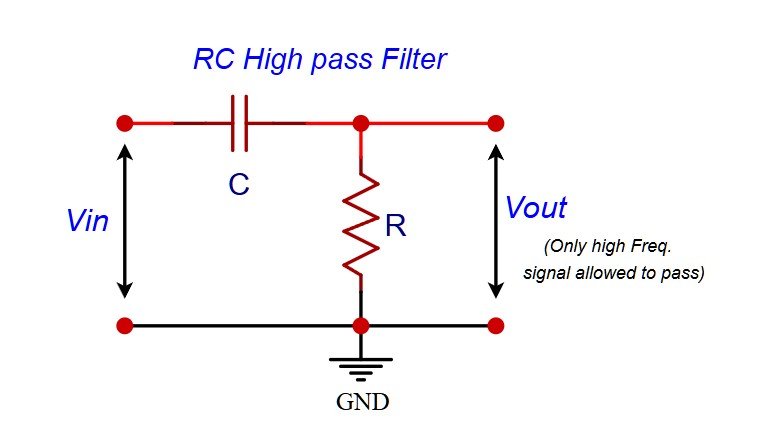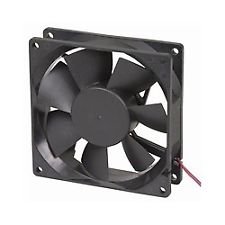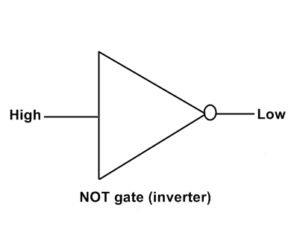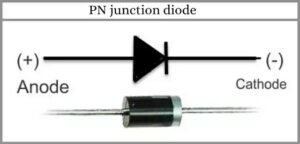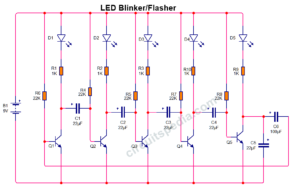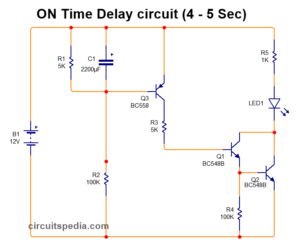Use our High-Pass Filter Calculator to easily calculate cutoff frequency, resistor, or capacitor values for RC and active filter circuits. Ideal for electronics and audio filter design projects.
High Pass Filter Calculator
Also try- Low pass filter calculator
High-Pass Filter Explained: Circuit Design, Types, Uses & Formulas
Electronic filters are crucial in signal processing, helping us isolate or suppress unwanted frequencies. One important category is the high-pass filter (HPF) — a powerful tool in both analog and digital electronics. Whether you’re working on audio systems, communication devices, or sensor circuits, understanding high-pass filters is essential.
In this guide, we’ll explore:
- what is high pass filter
- How it works
- Its types and real-world applications
- Circuit design with formulas
- FAQs to clear your doubts
Let’s dive in! 🔧📈
🔍 What is a High-Pass Filter?
A high-pass filter is a circuit that allows signals with a frequency higher than a certain cutoff frequency to pass through, while attenuating lower-frequency signals. It essentially blocks “low” and lets “high” go.
📈 High pass filter frequency response
In terms of frequency response:
- Frequencies above the cutoff: Pass through with little or no attenuation.
- Frequencies below the cutoff: Are attenuated (weakened) gradually or sharply.
Cutoff Frequency (fc)
The cutoff frequency is the point where the output signal drops to 70.7% (or -3 dB) of the input. This is the boundary between the “pass” and “attenuation” zones.
High pass filter working principle
Let’s start with a basic passive RC high-pass filter. It includes:
- A capacitor (C) in series with the input
- A resistor (R) connected to the ground after the capacitor
Basic RC High-Pass Filter Circuit:
High pass filter formula
Formula for Cutoff Frequency:
Where:
- fc = cutoff frequency (Hz)
- = resistance (ohms)
- = capacitance (farads)
The capacitor blocks low frequencies by acting as an open circuit at low f, and allows high frequencies by acting as a short at high f.
Applications of High-Pass Filters
High-pass filters are used in almost every electronics domain. Here are some key applications:
🎵 1. Audio Systems
- Tone control- To remove low-frequency signals or remove hum or noise (e.g., < 60 Hz).
- In tweeters (speakers that handle high frequencies).
2. Communication Systems
- For modulation and demodulation.
- To eliminate DC offsets or drift.
3. Power Supplies
-
To filter out ripple or unwanted low-frequency components.
4. Sensor Circuits
-
In biomedical sensors (like ECGs) to remove baseline wander.
5. Digital Signal Processing (DSP)
-
As software filters in image and sound processing.
Types of High-Pass Filters
High-pass filters can be broadly categorized into analog and digital, and further into passive or active.
1. Passive High-Pass Filter
It uses only passive components: resistors, capacitors, and/or inductors.
✅ Advantages:
- Simple and cost-effective
- No power supply needed
❌ Disadvantages:
- Cannot amplify signals
- Limited control over filter characteristics
Example: RC High-Pass Filter
2. Active High-Pass Filter
Includes active components like operational amplifiers (Op-Amps) in addition to R and C.
✅ Advantages:
- Can amplify signals
- Better performance at low frequencies
- Higher input impedance and lower output impedance
❌ Disadvantages:
- Requires power supply
- Slightly complex
Example:
First-order Active HPF using Op-Amp.
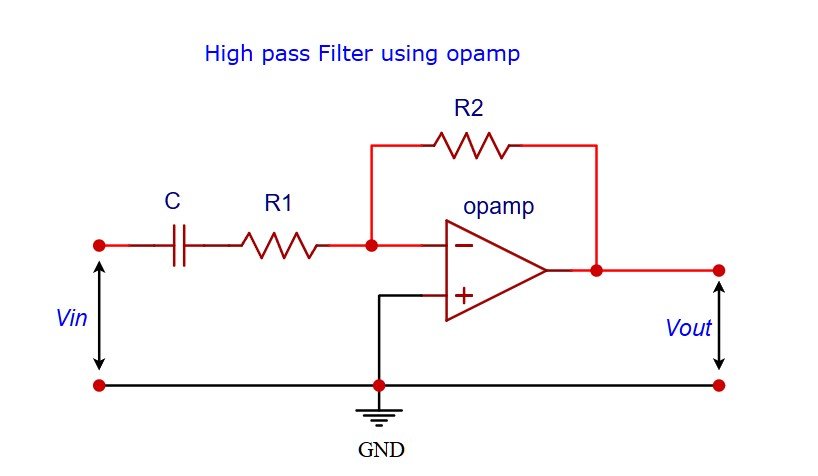
3. First-Order and Second-Order High-Pass Filters
Filters are also categorized by their order, which affects the steepness of the cutoff.
A high-pass filter allows high-frequency signals to pass while attenuating low-frequency signals. The order of a high-pass filter refers to the steepness of its frequency response or roll-off rate after the cutoff frequency. Here’s the difference between first-order and second-order high-pass filters:
First-Order High-Pass Filter
✅ Key Features:
- Contains one reactive component (a capacitor or inductor).
- Roll-off rate: -20 dB/decade (or -6 dB/octave).
- Simple circuit design, typically RC (Resistor-Capacitor) or RL (Resistor-Inductor).
Formula (RC Circuit)
Cutoff Frequency (fc):
Circuit Diagram:
Second-Order High-Pass Filter
✅ Key Features:
- Contains two reactive components (like two capacitors or an op-amp + RC pair).
- Roll-off rate: -40 dB/decade (or -12 dB/octave).
- Sharper and more selective cutoff response than first-order.
Transfer Function:
Where:
- Often implemented using active filters (op-amps) for better gain and stability.
- May use Sallen-Key topology for second-order active HPFs.
🔍 Comparison Table
- Use first-order for basic, low-cost filtering.
- Use second-order when you need a steeper cutoff and better performance, especially in audio, instrumentation, or communication systems.
Let me know if you’d like circuit diagrams for both or a comparison graph!
- First-order: Attenuates at -20 dB/decade after cutoff.
- Second-order: Attenuates at -40 dB/decade (steeper).
Second-order filters use two capacitors and two resistors (or inductors), and can be designed using the Sallen-Key topology.
Active First-Order High-Pass Filter:
Using a non-inverting Op-Amp configuration.
Gain is given by:
Where:
- Rf = feedback resistor
- R1 =from inverting input to ground
Second-Order Active High-Pass Filter (Sallen-Key)
The Sallen-Key topology is commonly used for precision filtering.
Where
Q is the quality factor that determines the sharpness of the filter.
📊 Graph: Frequency Response Curve
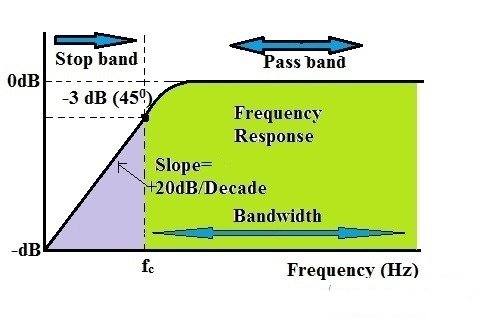 A frequency response graph typically shows:
A frequency response graph typically shows:
- X-axis: Frequency (log scale)
- Y-axis: Gain (dB)
At fc gain drops to -3 dB.
Above fc, gain stabilizes.
Below fc, gain rolls off.
High pass filter design
Passive RC High-Pass Filter:
As explained earlier:
Example:
Suppose we want
and we use
Then,
🛠 High-Pass Filter Design Tips
- Select accurate components: Tolerance matters near cutoff frequency.
- Use Op-Amp with good bandwidth for active designs.
- Simulate before building using tools like LTSpice or Falstad.
- Consider loading effects when connecting to other stages.
Digital High-Pass Filters
In digital systems, high-pass filtering is done using digital signal processing (DSP) techniques.
Common Types:
- Finite Impulse Response (FIR) filters
- Infinite Impulse Response (IIR) filters
They use mathematical algorithms instead of physical components.
A simple digital HPF formula:
Where:
- x[n]= input signal
- a= filter coefficient (0 < a < 1)
🧠 Real-World Examples
- Smartphones: Remove background hum from voice.
- Guitar pedals: Enhance treble in audio signal.
- Medical devices: Eliminate slow-changing offsets in ECG signals.
- Wi-Fi modems: Filter out noise from nearby electrical equipment.
❓ Frequently Asked Questions (FAQs)
1. What is the main difference between low-pass and high-pass filters?
A low-pass filter passes low frequencies and blocks high ones. A high-pass filter does the opposite.
2. Can I build a high-pass filter using inductors?
Yes! An LC high-pass filter uses an inductor and capacitor instead of a resistor.
3. What happens at the cutoff frequency?
The output signal’s power drops to 50% (or voltage drops to 70.7%) of the input. This is the -3 dB point.
4. Is it better to use active or passive HPF?
It depends. Use passive for simplicity and low cost, active when you need amplification and better performance.
5. Can a high-pass filter remove DC?
Yes. A high-pass filter with a very low cutoff frequency can effectively block DC signals (0 Hz).
6. How does a digital high-pass filter differ from an analog one?
Digital filters use software and mathematical operations. Analog filters use physical components like resistors and capacitors.
Conclusion
A high-pass filter is a powerful and versatile circuit used in nearly every electronic system. From removing unwanted noise in audio systems to preparing signals in communication equipment, HPFs play a vital role in modern electronics.
More from this site-
- Watt to ampere converter | Power to current conversion
- Bird sound generator circuit
- What is zero crossing detector
- What is optocoupler

